Foreword
Entrusted by the Municipal Education Bureau, Shenzhen Construction Research Institute Co. In the process of preparation, the preparation team has been extensively investigated and researched, carefully summed up the practical experience, and made reference to relevant international standards and advanced foreign standards, and formulated this standard on the basis of extensive solicitation of opinions.
The main technical contents of this procedure are: 1 General Provisions; 2 Terms; 3 Basic Regulations; 4 Technical Requirements; 5 Construction Management; 6 Synthetic Materials for Runway Surface Construction; 7 Composite Material Ball Surface Layer Construction; 8 Artificial Turf Construction; 9 Acceptance and Test; 10 Site management and maintenance of composite materials; appendices, etc.
This standard is managed by Shenzhen Housing and Construction Bureau, and Shenzhen Institute of Building Research Co., Ltd. is responsible for the interpretation of specific technical content. If you have any comments or suggestions during the implementation process, please send it to Shenzhen Institute of Building Research Co., Ltd. (Address: No.29 Meilu 3rd Road, Meilin, Futian District, Shenzhen, zip code: 518049) for future reference.
This standard is composed of: Shenzhen Institute of Building Research Co., Ltd.
1 General
1.0.1 To standardize the control of the quality of the ground floor of the sports ground of synthetic materials, and to achieve advanced technology, economical rationality, environmental friendliness, safe application and quality assurance, this standard is formulated.
1.0.2 This standard is applicable to the design, material selection, construction, test and acceptance of the ground floor of sports grounds for teaching and gymnasiums used in the construction and reconstruction of new and reconstructed and expanded buildings in Shenzhen. Other types of synthetic material sports grounds (playgrounds, community fitness venues, etc.) Urban greenways, children's activity venues, etc.) Refer to this standard according to the type of materials and construction process.
1.0.3 In addition to meeting this standard, the quality control of the ground floor of a synthetic sports ground shall comply with the relevant national standards.
2 Terms and classification
2.1 Terms
2.1.1 Synthetic Sports Ground Synthetic Sports Surface
Sports ground floor paved with a polymer synthetic material. According to the use of functions, it is mainly divided into runway surface layer, ball scene layer and artificial turf.
2.1.2 In-situ casting surface
Prefabricates and other raw materials produced by the factory are cast on the surface of the pavement.
2.1.3 prefabricated surface
At the factory, the coils or blocks are pre-prepared to be bonded or assembled on the surface.
2.1.4 artificial turf artificial turf
Imitation grass-like synthetic fibers are embedded in a woven base fabric, and the back surface is coated with a fixed-effect coating to simulate the performance of a natural grass sports field.
2.1.5 artificial turf surface
The ground floor, which is paved with artificial turf, is filled with quartz sand and rubber granules if necessary.
2.1.6 Prefabricated rubber roll
Prefabricated at the factory, used for the laying of rubber flooring on sports grounds.
2.1.7 polyurethane colloids polyurethane major ingredient
The main raw material that constitutes the cast-in-place polyurethane surface layer, divided into single components and two components.
2.1.8 Acrylic colloids acrylic acid major ingredient
The main raw material that constitutes the cast-in-place acrylic surface layer.
2.1.9 Filling particles infill granules
Filled with particles in cast-in-place finishes and artificial turf.
2.1.10 anti-skidding granules
The colloidal material is bonded to the surface of the cast-in-place surface layer to provide anti-slip and wear-resistant particles.
2.1.11 primer layer of synthetic surface
The lower layer of the cast-in-place surface layered structure is formed by mixing the colloidal main material and the filling particles and then solidifying.
2.1.12 upper layer of synthetic surface
The upper layer of the cast-in-place surface layer structure laid in layers is formed by mixing the colloidal main material and anti-slip particles and curing.
2.1.13 Adhesive Adhesive
When artificial turf and prefabricated surface layer are applied, adhesives used for splicing and adhesives for bonding materials to the base layer are used.
2.1.14 Marking paint
Used as a special paint for the marking of the ground layer of synthetic materials.
2.1.15 Tensile strength
In a tensile test, the maximum tensile stress that the specimen undergoes until it breaks.
2.1.16 Elongation at break
The ratio of the displacement of the material when it is broken and the original length.
2.1.17 Aging resistance
Sports ground floor materials have the property of delaying the delay of aging.
2.1.18 flame retardance
The floor of the composite sports ground has the property of delaying flame spread.
2.1.19 release rate
The amount of target hazardous material emitted into the air from the surface of the surface material per unit area per unit time.
2.1.20 Volatile organic compounds (TVOC) total volatile organic compounds
Under normal pressure, the boiling point of 50 °C ~ 260 °C various organic compounds.
2.2 Classification
2.2.1 Synthetic materials The ground layer of the sports ground is divided into polyurethane type surface layer, acrylic surface layer, polyurea surface layer and the like according to the material type.
2.2.2 Synthetic materials The ground floor of the sports ground is divided into cast-in-place and prefabricated types according to the paving method.
2.2.3 cast-in-place surface layer according to the structure is divided into breathable, composite, hybrid, all-plastic and so on.
2.2.4 The prefabricated surface layer is divided into prefabricated coils and blocks by shape.
2.2.5 Artificial turfs are divided into filled and unfilled types according to the structure.
3 Basic regulations
3.0.1 The material selection and design of the ground floor of the composite sports ground shall be in accordance with GB/T 14833, Tracks for Synthetic Tracks, Primary Sports Equipment and Venues, Part 11: Surfaces for Synthetic Materials, GB/T 19851.11, Artificial Materials. Requirements and testing methods for sports venues Part 3: Artificial grass surface for football fields GB/T 20033.3, Artificial Grass for Sports GB/T 20394, Requirements and testing methods for sports fields Part 1: Track and field venue GB / T 22517.6, "Technical Regulations for Sports Facilities in Primary and Secondary Schools" JGJ/T 280.
3.0.2 Synthetic materials The ground floor of sports grounds shall be designed by design units with design experience and corresponding performance.
3.0.3 Basic acceptance before surface construction. The quality control and acceptance of the site foundation shall comply with the current national standard “Unified Standard for Acceptance of Construction Quality of Buildings†GB 50300, “Code for Acceptance of Construction Quality of Foundations for Buildings†GB 50202, “Code for Construction and Acceptance of Asphalt Pavements†GB 50092, and “Concrete Concrete “Pavement Construction and Acceptance Specifications†GBJ97 and other standards. Grass-roots harmful substances must not adversely affect surface quality.
3.0.4 The unit responsible for the construction of the ground layer of the composite material sports ground shall have corresponding construction experience, and shall have a sound engineering quality management system, a safety production management system and a quality inspection system.
3.0.5 The ground floor construction of the compound material playground in schools and kindergartens shall not affect education and teaching activities.
3.0.6 The variety of materials selected for the composite sports venue should be determined according to the requirements of design, construction, etc. The selected materials should meet the requirements of environmental protection and should not have harmful effects on the human body, organisms and the environment.
3.0.7 Raw materials entering the site shall be witnessed and tested. Unqualified materials shall not be used for the project.
3.0.8 After the completion of the construction, the physical properties of the surface layer of synthetic materials and the content of harmful substances shall be witnessed and checked. Acceptance before passing can be put into use.
3.0.9 It is not allowed to add any materials other than formulas on the construction site.
3.0.10 It is strictly prohibited to use gasoline and solvents containing benzene, toluene, xylene, carbon disulfide, and methylene chloride during the construction of the surface layer of synthetic materials.
3.0.11 The geological period of the synthetic material field shall not be less than 3 years. The warranty should include blistering, cracking, delamination, turf perimeters, and open seams, grass tufts, etc.
3.0.12 After the completion of the ground floor of the composite sports ground, the user shall be trained in the daily maintenance and maintenance of the site.
4 Technical requirements
4.1 General requirements
4.1.1 When the raw materials come into the market, the supplier shall provide quality certification documents to the demanding party in accordance with the stipulated batch, and shall submit inspections in batches. The inspection unit shall be a third-party testing agency with relevant qualifications.
4.1.2 The mass percent of the particles used for filling the runway primer layer of the breathable synthetic material shall not exceed 80%.
4.1.3 The mass percentage of filler particles used in the composite layer of synthetic synthetic track materials and synthetic materials shall not exceed 25%.
4.1.4 The use ratio of inorganic fillers on the runway and ball surface layer of synthetic materials shall be less than 60%.
4.1.5 The mass percentage of rubber anti-skid granules should be greater than 20%.
4.2 Limits of Raw Material Harmful Substances
4.2.1 The limits of harmful substances in materials such as ground colloid materials, prefabricated rubber coils, blocks, and rubber granules in the composite material field shall meet the requirements in Table 4.2.1.
Table 4.2.1 Limits of Raw Material Harmful Substances in Ground Floor of Composite Material Yard
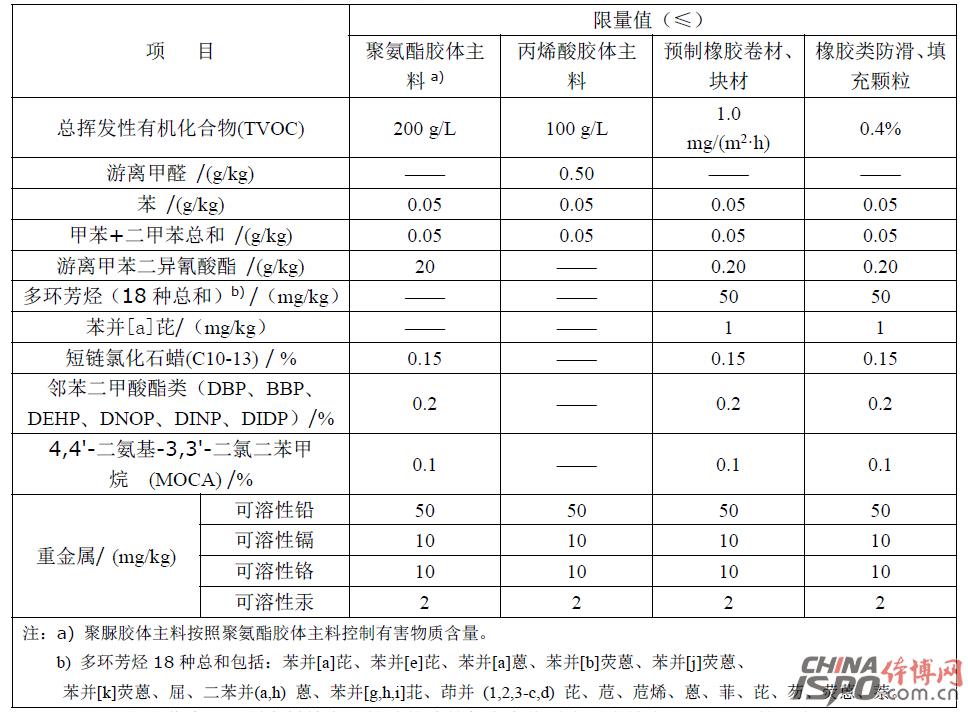
4.2.2 The content of harmful substances in adhesives used for bonding of artificial turf, prefabricated coils, etc. shall meet the requirements of GB 18583.
4.2.3 The content of harmful turf of artificial turf should meet the requirements of Table 4.2.3.
Table 4.2.3 Limits of artificial turf harmful substances
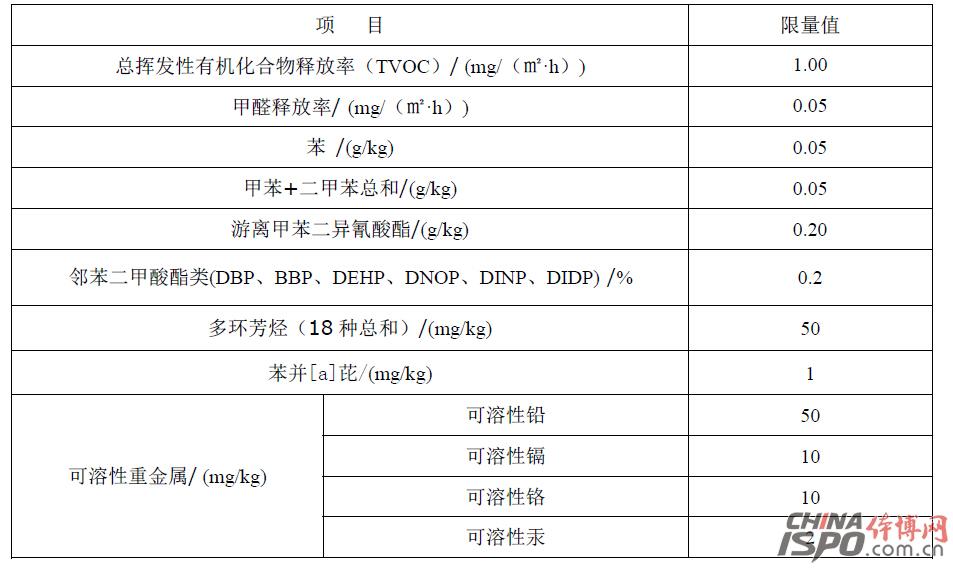
4.3 Prefabricated Coil, Artificial Turf Physical Properties
4.3.1 Prefabricated coil
The physical properties of prefabricated coils are to comply with the requirements of Table 4.3.1.
Table 4.3.1 Physical Properties of Prefabricated Rolls

4.3.2 Artificial turf
4.3.2.1 Physical and chemical properties
The physical and chemical properties of artificial turf should meet the requirements of Table 4.3.2.1.
Table 4.3.2.1 Requirements for physical and chemical properties of artificial turf

4.3.2.2 Mechanical properties
Artificial turf mechanical properties should meet the requirements of Table 4.3.2.2.
Table 4.3.2.2 Artificial turf mechanical properties requirements
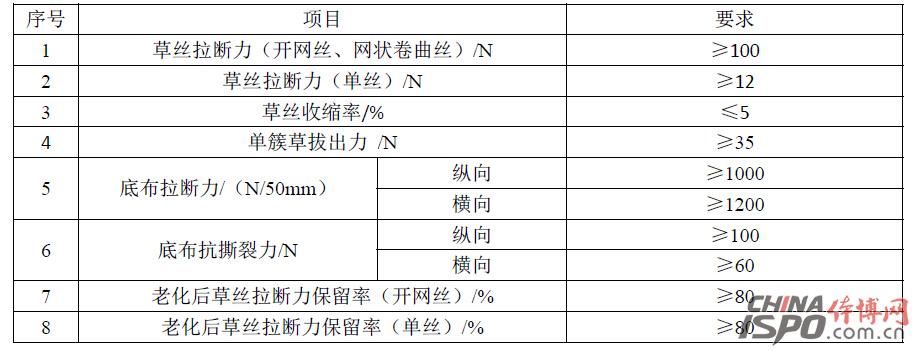
4.4 Composite Material Surface Physical Properties
4.4.1 The physical properties of the track surface of synthetic materials shall comply with the requirements of Table 4.4.1.
Table 4.4.1 Synthetic material runway surface physical properties

4.4.2 The physical properties of the synthetic ball sphere shall comply with the requirements of Table 4.4.2.
Table 4.4.2 Physical properties of the ground floor of synthetic materials
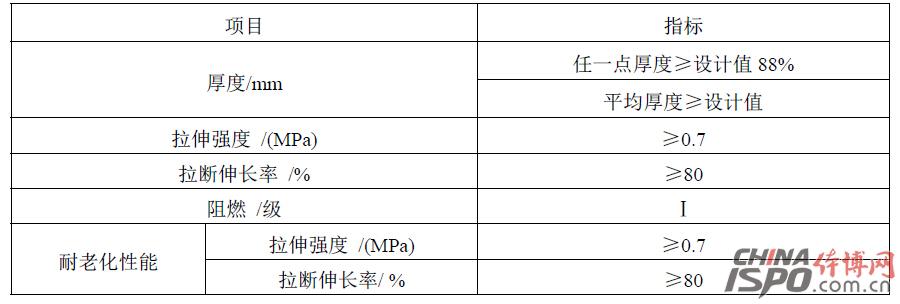
4.5 Requirements for Limits of Harmful Substances in Composite Materials
4.5.1 The content of harmful substances in the surface layer of cast-in-place synthetic material shall meet the requirements in Table 4.5.1.
Table 4.5.1 Limits of harmful substances on the surface of cast-in-place synthetic material field
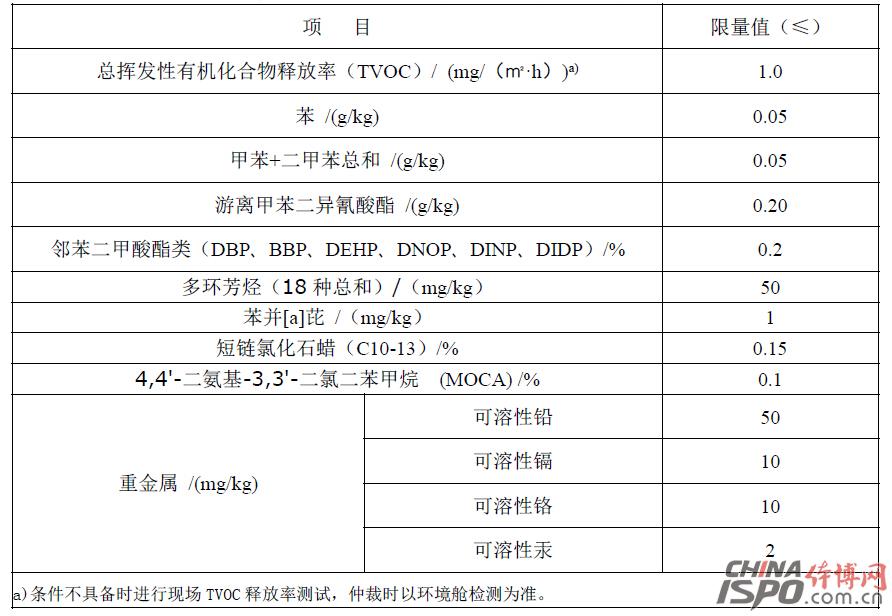
4.5.2 Indoor composite materials The environmental quality of sports venues shall comply with the relevant requirements of GB 50325 for formaldehyde, benzene and TVOC.
4.5.3 The surface odor level assessment of synthetic material surface shall not be greater than Grade 2.
5 Construction Management
5.1 General requirements
5.1.1 The construction unit shall be constructed according to the engineering design drawings, and shall not modify the engineering design without authorization.
5.1.2 The construction unit shall inspect the raw materials in accordance with the engineering design requirements, relevant standards and the contract, and shall use the products after passing the experience.
5.1.3 Prior to construction, plans for construction organization design or construction shall be prepared and a project quality management system, safety production management system and quality inspection system shall be established.
5.1.4 The construction unit shall establish a self-inspection, mutual inspection and full-time personnel inspection system for each process, and shall have a complete construction inspection record.
5.1.5 Strictly control the selection of raw materials, inspection prior to entry, and process control during construction.
5.1.6 The proportion of various raw materials shall be determined before the pre-construction test trial match. Once it is determined, the construction shall be measured according to the mix ratio, and any personnel shall not be arbitrarily adjusted.
5.1.7 Before the construction of cast-in-place surface, the model shall be produced according to the formula and construction process under the witness of the supervisor. During the construction, the model shall be used as the construction standard for construction.
5.2 Preparation before Construction
5.2.1 Technical preparation. Gradually familiar with the drawings to understand the design intent, and organize the construction unit, design and construction tripartite review of the sports field design drawings, the construction staff to arrange the construction program and technical disclosure.
5.2.2 site preparation. Investigate the site and collect weather information to ensure that the construction progress is not affected by the temperature and humidity of the climate. Temporary offices and temporary material warehouses were set up to delineate the construction site.
5.2.3 Production preparation. Through the cooperation of the construction unit, the necessary construction permit formalities are obtained; the construction unit provides the construction unit with the certificate of origin and certificate of the origin of the raw materials; a third-party qualified testing agency conducts sample inspection on the raw material samples; implements the supply of mechanical tools, allocates construction forces, and organizes labor force Admission, organization of personnel for safety production education and technical disclosure, all departments to develop work plans and operating rules.
5.3 Safe and Civilized Construction Measures
5.3.1 Fully implement the responsibility system for safety production, and establish and implement a step-by-step post responsibility system in accordance with the principle of “who is responsible for managementâ€.
5.3.2 Establish a safe and civilized construction management team to strengthen the management and education of workers' safe and civilized construction, and be responsible for the rewards and penalties.
5.3.3 The site has the necessary quality assurance, safe production, and civilized construction publicity. There are safety propaganda slogans and safety warning signs in the main construction sites, main passages and dangerous areas. All signs are as uniform as possible to form standardization.
5.3.4 Stacking of all material tools shall be stacked according to the area determined by the general layout drawing of the construction site, and shall be marked at the conspicuous places in the area and stacked neatly. Properly arranged material houses and equipment shall be well protected against moisture, leakage and fire. .
5.3.5 The management of volatile solvents used in the field shall comply with the relevant national regulations on dangerous goods management.
6 Composite Runway Surface Construction
6.1 General requirements
6.1.1 During the construction of the composite material runway, the minimum temperature in the construction environment during the daytime should be greater than 15°C, and the minimum temperature in the evening should not be lower than 8°C. Class 5 and
Above, wet conditions and wet conditions after the rain, surface construction should not be carried out.
6.1.2 There should be mechanical equipment that meets the construction requirements.
6.1.3 The construction, batching and mixing sites should be cleaned up, and the ingredients and the surrounding area should be kept flat and clean;
6.1.4 The surface of cement concrete foundation shall be covered with a waterproof layer.
6.2 Basic acceptance
6.2.1 The asphalt concrete base layer shall be maintained for more than 10 days, and the cement concrete base layer shall be maintained for more than 28 days;
6.2.2 The base surface should be calendered, clean and dry, free of oil, and should not have ruts, hard knots, sinks, cracks or openings. Concrete-based expansion joints should be cleaned and there should be no dust in the expansion joints.
6.2.3 The site should have good drainage performance, and the foundation flatness and slope should meet the design requirements.
6.2.4 The density of the asphalt base shall not be less than 95%, and the strength of the concrete foundation shall not be less than C25.
6.3 Raw Material Storage
6.3.1 The construction site should be equipped with storage containers and should meet the following requirements:
1 The quantity and capacity of storage containers should meet the requirements for different varieties and supply quantities;
2 When the storage container is used, there should be no debris or clear water inside;
3 storage containers should be sealed, non-absorbent;
4 storage containers should be easy to store and access;
5 There should be rain protection measures when accessing.
6.3.2 Different types of materials should be stored in different storage containers, and the storage containers should be identified. The contents of the identification should include the variety and time limit of use.
6.3.3 The ambient temperature of the raw material storage site should not be less than 8°C.
6.4 Hybrid Composite Runway
6.4.1 The surface of the composite composite material should be constructed in the following order:
1 testing, leveling the venue;
2 isolation layer;
3 adhesive layer construction;
4 spraying or scattering non-slip particle surface layer;
5 crossed lines.
6.4.2 When laying the primer layer, the polyurethane compound rubber and filler particles should be mixed in proportion and spread on the base layer. The thickness of the polyurethane adhesive should meet the design requirements.
6.4.3 The laying of the surface layer of a hybrid synthetic material shall comply with the following provisions:
1 Sprinkle granules craft: The two-component polyurethane rubber material stirs according to the proportion, spreads on the bottom adhesive layer, sprinkles the non-slip particle then, also may brush the protective glue on the non-slip particle;
2 spray-type process: the surface layer of glue and anti-skid particles in a certain proportion of mixing, spray evenly in the primer layer.
6.4.4 Cleaning and marking should meet the following requirements:
1 According to the design requirements, the surface of the composite material shall be fully paved and the site shall be cleaned as a whole. Runway synthetic material surface should be dry, no moisture;
2 Use marking paint according to design requirements.
6.5 Breathable synthetic track
6.5.1 The construction of breathable synthetic track surface shall be performed in the following order:
1 testing, leveling the venue;
2 isolation layer;
3 brushing primer;
4 Laying a rubber-filled primer layer;
5 Spray anti-slip particle surface layer;
6 crossed lines.
6.5.2 The laying of breathable composite track surfaces shall comply with the following provisions:
1 The primer layer is made of polyurethane adhesive and filled rubber granules and stirred in a certain proportion and spread on the base layer with a paving machine;
The two-sided adhesive layer shall be uniformly sprayed on the primer layer after mixing the surface layer glue and the non-slip particles in a certain proportion.
6.5.3 Lines should meet the following requirements:
1 The surface of the composite material shall be fully laid out according to the design requirements and the site shall be cleaned as a whole. Runway synthetic material surface should be dry, no moisture;
2 Use marking paint according to design requirements.
6.6 Prefabricated composite runways
6.6.1 The prefabricated synthetic track surface construction shall be carried out in the following order:
1 Testing, grinding, leveling the site;
2 isolation layer;
3 adhesive layer;
4 prefabricated rubber track surface;
5 crossed lines.
6.6.2 The laying of prefabricated synthetic track surfaces shall comply with the following provisions:
1 In the case of any bending or folding of prefabricated rubber track membranes, there should be no cracking or cracking;
2 When the pavement is completed, the surface layer is free from delamination or empty drums, the joints should be smooth, there should be no gaps in the joints and stepwise bumps should not occur.
3 roots are lined with marking paint according to design requirements.
6.7 Construction Inspection
6.7.1 The construction unit is responsible for the overall inspection of the flatness, slope, thickness, water level, and rule line position of the entire site. After determining that all the design requirements are met, the data and records shall be submitted to the construction unit for completion and the construction unit shall be required to complete the work as soon as possible. Organize acceptance of the site.
6.7.2 The person in charge of the construction site should lead other personnel to fully clean up the site, especially for machinery, materials, circuits, and sanitation, and to ensure that the construction team must be kept as it is before the construction team comes out. The withdrawal of civilization.
7 Synthetic Material Ball Scene Construction
7.1 General requirements
7.1.1 Construction environment The minimum temperature in the daytime should be greater than 15°C, and the lowest temperature in the evening should not be lower than 8°C. The surface layer construction shall not be carried out under the conditions of Grade 5 winds and above, wet weather and wet conditions after the rain.
7.1.2 There should be mechanical equipment that meets the construction requirements.
7.1.3 The construction, batching and mixing sites should be cleaned up, and the ingredients site and surroundings should be kept flat and clean.
7.1.4 The basic acceptance shall meet the requirements of 6.2 of this Regulation.
7.1.5 Raw material storage should meet the requirements of 6.3 of this regulation.
7.1.6 Construction self-test should meet the requirements of 6.8 of this regulation.
7.2 acrylic surface course
7.2.1 Acrylic surface coating construction should be carried out in the following order:
1 testing, leveling the venue;
2 isolation layer;
3 grass-roots structural layer;
4 middle structural layer;
5 elastic layer;
6 non-slip layer;
7 finishes;
8 crossed lines.
7.2.2 Acrylic surface coating construction shall meet the following requirements:
1 In the construction of the basic structural layer, after reinforcing the asphalt filler and mixing sand and water, it should be painted twice and the ground should be leveled;
2 During the construction of the intermediate structural layer, the layered squeegee shall be applied after the acrylic reinforcing filler is mixed with sand and water;
3 When the elastic layer is applied, the acrylic adhesive and the filling rubber particles should be mixed in proportion, and the layers should be drawn to the specified thickness.
4 When the anti-slip layer is applied, it should be stratified and scraped after the acrylic color concentrate quartz sand and water are stirred;
5 When the finish layer is applied, apply acrylic colorant concentrate and stir with water, then apply a layered squeegee;
6 When scribing, use the acrylic color concentrate to mark the white border twice.
7.3 Polyurethane Course Course
7.3.1 Polyurethane surface course construction should be carried out in the following order:
1 testing, leveling the venue;
2 isolation layer;
3 polyurethane primer layer;
4 Polyurethane topcoat;
5 Polyurethane reinforced layer;
6 Polyurethane finish
7 line.
7.3.2 The polyurethane surface coating construction shall meet the following requirements:
1 Ingredients should be uniformly mixed according to the product process ratio;
2 Bubbles should be avoided when coating the sealer.
3 When laying an elastic polyurethane primer layer, an elastic polyurethane surface layer, an elastic polyurethane layer, and an elastic polyurethane surface paint, the flatness of the previous layer shall be checked first, and the preceding layer shall be uniformly spread from the inside to the outside after being dried and stabilized;
4 When laying elastic polyurethane surface layer, use belt type sanding machine to grind back and forth in the venue, so that the surface layer is flat;
5 Level the test water, pour the water on a well-grounded site, check if there is any water accumulation area, mark the water accumulation area with paint if there is any stagnant water, and fill it with a well-mixed base material;
6 Apply a flexible polyurethane topcoat, uniformly mix the polyurethane topcoat and the anti-slip powder (silicon dioxide) in a certain proportion, and apply it to a well-prepared site with a roller or spray coating;
7 The trimming area should be trimmed, and trimmers should check the thickness and flatness at any time.
8 Use marking paint according to design requirements.
7.3.3 Silicon modified polyurethane surface layer construction is performed in accordance with the requirements of this section.
7.4 Precast Sheet Surface Course
7.4.1 The prefabricated coil surface construction shall be carried out in the following order:
1 Testing, grinding, leveling the site;
2 isolation layer;
3 adhesive layer;
4 grid layer;
5 prefabricated synthetic material sheet surface layer;
6 Cold welding joints;
7 line.
7.4.2 The laying of prefabricated coil surface shall meet the following requirements:
1 There should be no cracking or cracking of prefabricated coils under any bending or folding.
2 When the pavement is completed, the surface layer is free from delamination or empty drums, the joints should be smooth, there should be no gaps in the joints and stepwise bumps should not occur.
3 roots are lined with marking paint according to design requirements.
7.5 Polyurea Synthesis Surface
7.5.1 Polyurea elastomer surface course construction should be carried out in the following order:
1 testing, leveling the venue;
2 primary structural layer;
3 isolation layer;
4 Primer;
5 middle structural layer;
6 finishes;
7 finish;
8 crossed lines.
7.5.2 The construction of polyurea elastomer surface course shall meet the following requirements:
1 In the construction of the basic structural layer, after reinforcing the asphalt filler and mixing sand and water, it should be painted twice and should be cracked and leveled;
2 Primer is coated with professional primer and roller coating. The coating should be even and without any coating. Knife with paint, now with the current use;
3 The intermediate structural layer shall be conducted within 24 to 48 hours after the primer is applied. The site shall be coated by delamination. After each layer of squeegee is applied, it shall be immediately examined to find defects and be disposed of;
4 The construction of the facing layer shall be carried out after the polyurea coating is finished for 12 hours. Before construction, ensure that the base surface is clean and dry. Topcoats are applied by brush or roller;
5 roots are lined with marking paint according to design requirements.
8 Artificial turf construction
8.1 General requirements
8.1.1 The surface layer construction shall not be carried out under the conditions of Grade 5 winds and above, wet conditions after rain and rain.
8.1.2 The turf bonding environment temperature should be better than 15 °C.
8.1.3 There should be mechanical equipment that meets the construction requirements.
8.1.4 The basic acceptance shall meet the requirements of 6.2 of this regulation.
8.1.5 Raw material storage should meet the requirements of 6.3 of this regulation.
8.1.6 Construction self-test should meet the requirements of 6.8 of this regulation.
8.2 Construction Process
8.2.1 Artificial turf surface construction should be carried out in the following order:
1 Site foundation acceptance;
2 pavements;
3 artificial turf bonding;
4 review point line;
5 Filled site pavement fillings.
8.2.2 Artificial turf paving should meet the following requirements:
1 Positioning should be carried out, the positioning of the line is accurate, and the function line is marked straight and clear;
2 Place the grass roll and push the turf according to the site positioning line code to ensure that the edge line does not bend and the grass surface has no arching and folding;
3 After turf pushing, it should be awake, and the stretch rate should be greater than 95%;
4 The special cutting knife should be used to cut off the excess base cloth in a flush manner. The grass seedling shall not be cut, and the seam gap shall not be greater than 3mm.
8.2.3 Artificial turf bonding shall meet the following requirements:
1 Before bonding, it is necessary to clean the underside of the turf and connect the belt to ensure that the surface is dry and free of water;
2 Brush the special glue on the bottom of the turf seam and the connecting belt respectively. After the glue is dry, stick it and hammer it with a rubber mallet to achieve no defects and no degumming at the joint. No bossing phenomenon is allowed.
3 It should be maintained for at least 3 days after completion of paving. Care should be taken during maintenance to avoid exposure, flooding, and movement.
8.2.4 Review the bit line of the installation site and fully check whether all the bonding positions are tightly bonded.
8.2.5 For filled sites, the filling process should meet the following requirements:
1 Using a professional filling machine to evenly spread sand of the specified specifications, and use a hard brush to brush back and forth to ensure that the sand is fully implemented. The exposed grass is neat and uniform, ensuring flatness;
2 Fill the rubber particles according to the actual product design specifications, and use a hard brush to comb the flat rubber particle filling layer to ensure that the grass sprouts exposed on the fillings stand vertically and have the same height to ensure flatness;
3 Use turf special glue to bond the turf to the surrounding concrete foundation firmly.
9 Acceptance and Test
9.1 General requirements
9.1.1 Acceptance of raw materials used for the surface layer of composite materials shall be subject to acceptance. The construction unit shall provide product certification, instructions and inspection reports within one year. The test report provided by the construction unit shall include the parameters specified in 4.2 and 4.3.
9.1.2 The composite material surface course shall witness the approach of raw material inspection and surface quality inspection under the witness of the construction unit or the supervision unit. The inspection shall be undertaken by a qualified third-party testing agency.
9.1.3 After the completion of construction of the composite material surface layer, the physical properties, hazardous substance content detection and on-site air odor grade assessment shall be carried out in accordance with 9.2.4-9.2.7. The inspection should be conducted after the completion of the construction 14 days. The site test can be put into use.
9.1.4 The quality of the project's perception, dimensions, etc. shall be jointly confirmed by inspection personnel through on-site inspections.
9.2 Raw Material Entry Inspection and Surface Quality Inspection
9.2.1 The entry detection items for harmful substances such as colloidal materials, prefabricated rubber coils, blocks, artificial turf, and rubber granules shall meet the requirements of Table 9.2.1.
Table 9.2.1 Entry detection items for hazardous materials on the ground floor of the composite material yard
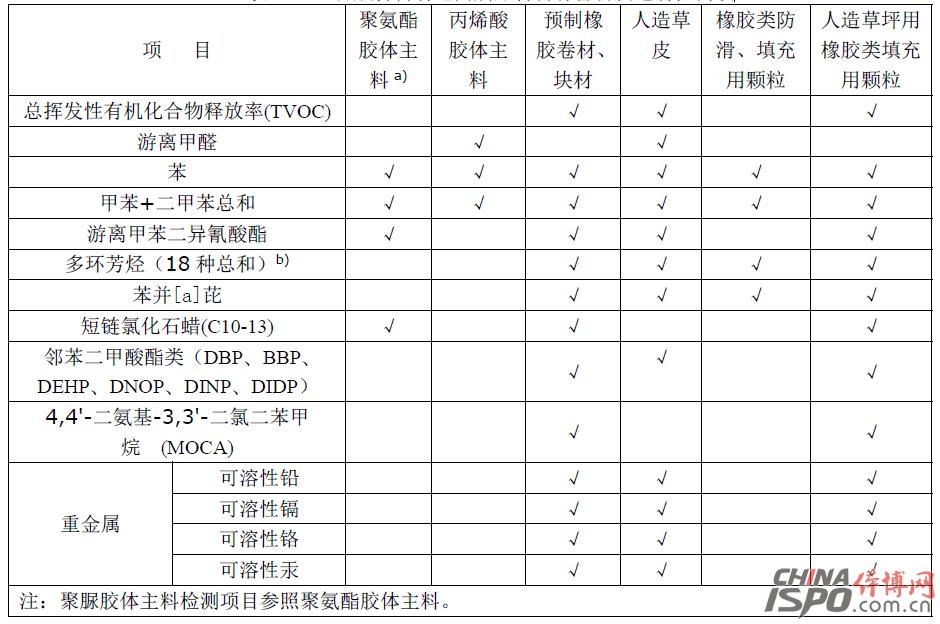
9.2.2 The entry detection items for hazardous substances in solvent-based adhesives for the bonding of artificial turf, prefabricated coils, etc. shall comply with the requirements of Table 9.2.2-1, and the entry detection of hazardous substances in water-based adhesives. Should meet the requirements of Table 9.2.2-2.
Table 9.2.2-1 Detection Items for Harmful Substances in Solvent Type Adhesives

Table 9.2.2-2 Pest Detection Items in Water-based Adhesives

9.2.3 The physical property approach test items for prefabricated coils shall comply with the requirements of Table 9.2.3-1. The physical properties approach test items for artificial turf shall comply with the requirements of Table 9.2.3-2.
Table 9.2.3-1 Prefabrication of physical properties of prefabricated coils

Table 9.2.3-2 Artificial turf mechanical performance approach testing project
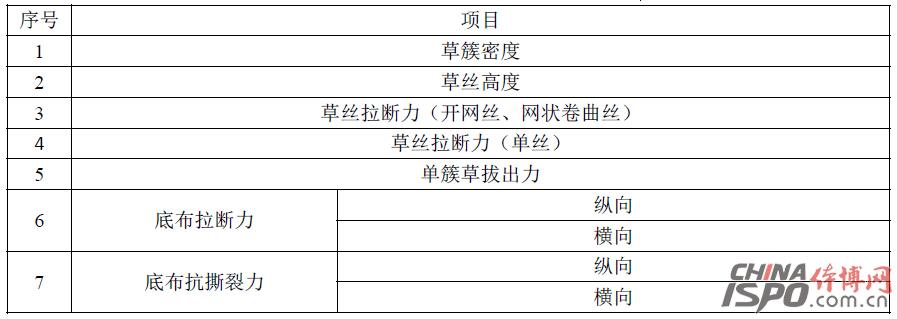
9.2.4 Physical properties of cast-in-place surface shall comply with the requirements in Table 9.2.4.
Table 9.2.4 Composite Material Surface Physical Performance Testing Project

9.2.5 Inspection items for hazardous contents of cast-in-place surface shall comply with the requirements in Table 9.2.5.
Table 9.2.5 Harmful Substances Detection in the Ground of Synthetic Materials Field
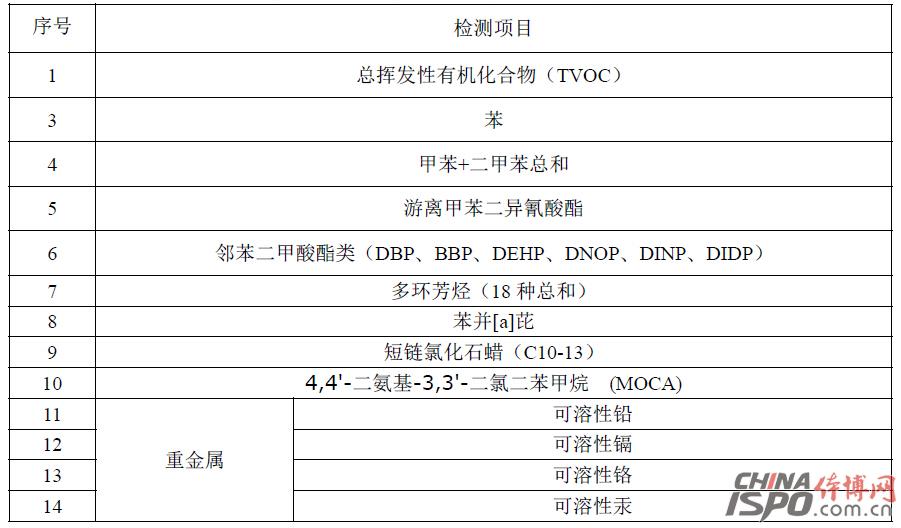
9.2.6 Indoor composite materials Sports venues should be tested for formaldehyde, benzene, and TVOC.
9.2.7 Synthetic material surface air shall be assessed for odor level.
9.3 Sampling and Determination
9.3.1 The raw materials entering the site and the surface after completion of the construction should be tested in batches.
9.3.2 The same raw material produced by the same manufacturer shall be the same raw material for the same construction site as an inspection lot.
9.3.3 The number of measuring points of the surface layer thickness of the composite material shall be extracted according to the provisions in Table 9.3.3-1. The sampling of other testing items on the surface of the composite material shall be in accordance with Table 9.3.3-2.
The provisions of the extraction, the specific measurement points according to the shape of the site using diagonal lines, slashes, plum-like uniform distribution points. Laboratory test samples should be on the scene
The layer is cut off, and if the conditions are not allowed, the model made at the construction site can be used for testing.
Table 9.3.3-1 Thickness Inspection Sampling Rules
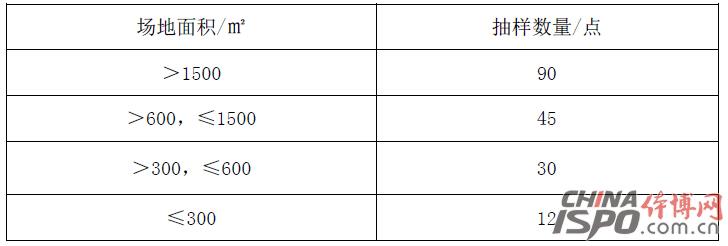
Table 9.3.3-2 Sampling Rules for Other Surface Inspection Items

9.3.4 Surface thickness, surface material odor assessment and on-site TVOC release rate testing shall be conducted on site; other physical properties and hazardous content shall be collected from the site and sent to the laboratory for testing.
9.3.5 If the site environmental conditions are not uniform, the most unfavorable area should be sampled.
9.3.6 Determination
9.3.6.1 Determination of laboratory test items and on-site TVOC release rate test
Each test point shall be tested and the results shall be calculated in accordance with the following provisions:
1 When the single point results meet the requirements of this regulation, the results are taken as the arithmetic mean;
2 When the single-point results do not meet the requirements of this regulation, the results should be the worst;
3 For physical performance, except for cases 1 and 2, when the relative error between the single-point result and the average value is less than 20%, the result is an arithmetic mean;
When the relative error between the single point result and the average value is greater than 20%, another double measurement point should be taken for re-inspection. If the relative error between the single point result and the average value is still greater than 20%, take the worst value;
4 For pest content, except 1 and 2 cases, when the relative error between the single point result and the average value is less than 50%, the result is taken as the arithmetic mean; when the relative error between the single point result and the average value is greater than 50%, Another double checkpoint is used for re-inspection. If the relative error between the single-point result and the average value is still greater than 50%, take the worst value.
9.3.6.2 Field Surface Thickness
Thickness test results shall be evaluated in accordance with 4.4.
9.3.6.3 Surface material odor assessment shall be based on the worst assessment level of each measurement point as the comprehensive odor assessment level of the item.
9.4 Site Acceptance Procedures
9.4.1 The acceptance of the construction quality of the composite material surface layer shall meet the following requirements:
1 The project quality should meet the requirements of engineering survey and design documents;
2 Acceptance of project quality should be carried out on the basis of self-inspection and assessment by the construction unit.
3 Bear witness sampling and testing units should have corresponding qualifications;
4 The perception quality of the project should be checked by on-site inspection personnel and should be jointly confirmed.
9.4.2 The following documents and records should be checked during acceptance of the project quality:
1 Engineering drawings, design instructions and other design documents;
2 Material factory certificate, performance test report, site acceptance record and re-inspection report;
3 Acceptance records of the sub-projects;
4 Construction records.
9.4.3 On-site Inspection and Acceptance Contents and Requirements
1 The flatness and thickness of the synthetic surface should meet the design requirements;
2 The appearance of the synthetic surface layer is free from bubbles, cracks or delamination, and the seams must be straight and without obvious marks;
3 The bonding between the synthetic surface layer and the base layer should be firm, without degumming and unevenness;
4 The color of the synthetic surface should be uniform and consistent with the design requirements;
5 The logo line is straight, even, and free from imaginary edges.
9.4.4 Make an on-site assessment of the composite surface and make recommendations for rectification of the site in question.
9.5 Unacceptable surface treatment
9.5.1 When the surface layer physical performance test results do not meet the requirements, a rectification plan shall be formulated and implemented. If the rectification does not meet the requirements, the construction party and the designer shall decide on the treatment method.
9.5.2 When the content of harmful substances such as heavy metals, MOCA, PAHs, benzo[a]pyrene, SCCPs, phthalates, etc. exceeds the standards, they shall be replaced or dismantled;
9.5.3 When the content of volatile volatile substances such as TVOC, free formaldehyde, benzene, toluene + xylene, and free toluene diisocyanate exceeds the standard, the following requirements shall be handled:
1 If it exceeds 50%, it can be extended for 1 month before re-inspection, or rectification measures are taken. If it still does not meet the requirements, it should be replaced or dismantled;
2 Exceeding 50% of the limit, for replacement or dismantling.
9.5.4 When the on-site odor assessment level is 3, the cause should be further analyzed and rectification should be carried out. If the odor assessment level is still not up to the standard after 1 month, replace it or dismantle it. When the on-site odor assessment level is 4 or 5, dismantling shall be done.
9.6 Test Methods
9.6.1 Total volatile organics (TVOCs) shall be carried out as follows:
1 Colloidal materials and adhesives are tested according to the method of Appendix F of GB 18583-2008;
2 rubber particles according to GB/T 23986-2009 Method 1 test.
9.6.2 The release rate of TVOC for prefabricated coils, TVOC for artificial grass and formaldehyde release rate shall be tested according to the method of GB 50325.
9.6.3 The release rate of cast-in-place surface TVOC shall be tested in accordance with the method of Annex C of this regulation.
9.6.4 The free formaldehyde of the acrylic colloid and adhesive should be tested according to the method of GB 18583.
9.6.5 The sum of benzene, toluene + xylene, and free toluene diisocyanate are tested according to the method of GB 18583. The pretreatment method for solid materials
See Appendix A of this procedure.
9.6.6 Phthalates are tested according to GB/T 29608.
9.6.7 PAHs and benzo[a]pyrene were tested according to the method of GB/T 29614.
9.6.8 SCCPs were tested according to SN/T 2570.
9.6.9 The content of 4,4'-diamino-3,3'-dichlorodiphenylmethane (MOCA) was tested according to the method of HG/T 3711. The pretreatment method was according to the acetone extraction method of GB/T 7766.
9.6.10 Heavy metal content should be carried out as follows:
1 Soluble lead is tested according to the method of GB/T 9578.1;
2 soluble cadmium according to GB/T 9578.4 test;
3 Soluble chromium is tested according to the method of GB/T 9578.6;
4 Soluble mercury is tested according to the method of GB/T 9578.7;
5 The heavy metal pretreatment method is as per Appendix A of this regulation.
9.6.11 The thickness of prefabricated coils shall be tested in accordance with the method of GB 18173.1.
9.6.12 Cast-in-place surface layer thickness is tested according to the method of Annex B of GB/T 19851.11-2005.
9.6.13 The tensile strength and elongation at break of the composite material are tested according to the method of GB/T 14833.
9.6.14 Flame retardant properties of cast-in-place surface and prefabricated coils are tested according to the method of Annex E of GB/T 19851.11-2005.
9.6.15 The aging resistance of cast-in-place surface and prefabricated coils is tested according to the method of GB/T 14833.
9.6.16 The physical and chemical properties and mechanical properties of artificial grass are tested according to GB/T 20394.
9.6.17 The determination of the content of inorganic fillers in synthetic materials and the content of rubber anti-skid granules shall be carried out in accordance with GB/T 4498.1.
9.6.18 The odour assessment method is to be tested in accordance with Appendix B of this regulation.
10 Synthetic Materials Site Management and Maintenance
10.0.1 Management of site usage of synthetic materials shall comply with the following provisions:
1 Should be used reasonably according to its scope of adaptation;
2 All kinds of motor vehicles and heavy machinery are forbidden to enter the site, and it is forbidden to bring explosive, flammable and corrosive articles into the site;
3 Do not wear spiked shoes when entering the stadium;
4 Do not stack heavy objects on synthetic materials for long periods of time;
5 Keep the cleanliness of the venue, smoking, chewing gum and carrying sugar-containing colored beverages or foods.
10.0.2 The surface maintenance of synthetic materials shall meet the following requirements:
1 The surface of the synthetic material should be cleaned at any time. Sand, leaves, garbage, etc. should be regularly cleaned. The entire area should be washed once every quarter.
2 Before and after the application of synthetic material surface wash with water.
3 The various signs and lines on the runway should be kept clear and eye-catching. When faded, it should be redrawed.
When the ground floor of the 4 floors breaks or delaminates, it should be promptly repaired.
10.0.3 äººé€ è‰åªçš„养护应符åˆä¸‹åˆ—规定:
1 应定期养护,时间间隔ä¸åº”超过14d;
2 应ä¿æŒæ¸…æ´ã€åŠæ—¶æ¸…ç†æ‚物ã€æ±¡æºƒã€æ²¹æ¸;
3 ç‚Žçƒã€å¹²ç‡¥å¤©æ°”è¦å®šæœŸæ’’æ°´;
4 è‰åªå‘生æŸå时,应åŠæ—¶ä¿®è¡¥ã€‚
附录A 固æ€æ料有害物检测å‰å¤„ç†æ–¹æ³•
A.1 苯ã€ç”²è‹¯+二甲苯
A.1.1 å°†æ ·å“粉碎至粒径约为1mm3 的细å°é¢—粒,准确称å–粉碎åŽçš„æ ·å“1.0g(精确至0.0001g),置于50mL的容é‡ç“¶ä¸ï¼Œç”¨ä¹™é…¸ä¹™é…¯æº¶è§£å¹¶ç¨€é‡Šè‡³åˆ»åº¦ï¼Œæ‘‡åŒ€ã€‚é™ç½®15 分钟åŽç”¨å¾®é‡æ³¨å°„器å–上层清液1uL è¿›æ ·ï¼Œæµ‹å…¶å³°é¢ç§¯ã€‚è‹¥è¯•æ ·æº¶æ¶²çš„å³°é¢ç§¯å¤§äºŽè¡¨ä¸æœ€å¤§æµ“度的峰é¢ç§¯ï¼Œç”¨ç§»æ¶²ç®¡å‡†ç¡®ç§»å–V ä½“ç§¯çš„è¯•æ ·æº¶æ¶²äºŽ50mL 容é‡ç“¶ä¸ï¼Œç”¨ä¹™é…¸ä¹™é…¯ç¨€é‡Šè‡³åˆ»åº¦ï¼Œæ‘‡åŒ€åŽå†æµ‹ã€‚
A.2 游离甲苯二异氰酸酯
A.2.1 å°†æ ·å“粉碎至粒径约为1mm3 的细å°é¢—粒,准确称å–粉碎åŽçš„æ ·å“2.0~3.0g(精确至0.0001g)于50mL 容é‡ç“¶ä¸ï¼ŒåŠ å…¥5mL å†…æ ‡ç‰©ï¼Œç”¨é€‚é‡çš„乙酸乙酯稀释,é™ç½®15 分钟åŽç”¨å¾®é‡æ³¨å°„器å–上层清液1μL è¿›æ ·ï¼Œæµ‹å®šè¯•æ ·æº¶æ¶²ä¸ç”²è‹¯äºŒå¼‚氰酸酯和æ£å››å烷的色谱峰é¢ç§¯ã€‚
A.3 å¯æº¶æ€§é‡é‡‘属
A.3.1 åˆæˆæ料跑é“ã€åˆæˆææ–™çƒåœºé¢å±‚ã€äººé€ è‰åª
å°†æ ·å“粉碎至粒径约为1mm3 的细å°é¢—ç²’0.5g(精确至0.0001g)ï¼ŒåŠ å…¥25mL 0.07mol/L ç›é…¸æº¶æ¶²æ··åˆï¼Œæ…æ‹Œ1min,测其酸度,如pH>1.5,é€æ¸æ»´åŠ 浓度为2mol/L ç›é…¸æº¶æ¶²å¹¶æ‘‡åŒ€ï¼Œä½¿pH 在1.0~1.5 之间。在室温下连ç»æ…拌混åˆæ¶²1h,立刻用定é‡æ»¤çº¸è¿‡æ»¤å¹¶æ´—涤,用1%AgNO3 æº¶æ¶²æ£€éªŒè‡³æ— æ°¯ç¦»å,然åŽå‡†ç¡®å®šå®¹ï¼Œå°†æº¶æ¶²é¿å…‰ä¿å˜ï¼Œåº”在4h 内完æˆæµ‹è¯•ã€‚è‹¥4h å†…æ— æ³•å®Œæˆæµ‹è¯•ï¼Œåˆ™ä½¿ç”¨1mol/L çš„ç›é…¸æº¶æ¶²25ml å¯¹æ ·å“进行处ç†ï¼Œå¤„ç†æ–¹æ³•åŒä¸Šã€‚
A.3.2 èšæ°¨é…¯èƒ¶ä½“主料ã€ä¸™çƒ¯é…¸èƒ¶ä½“主料
å°†å¾…æµ‹æ ·å“按规定的比例混åˆå„ç»„åˆ†æ ·å“,æ…æ‹Œå‡åŒ€åŽï¼Œåœ¨çŽ»ç’ƒæ¿æˆ–èšå››æ°Ÿä¹™çƒ¯æ¿(需用1:1 çš„ç¡é…¸æº¶æ¶²æµ¸æ³¡24h,然åŽç”¨æ°´æ¸…洗并干燥)上制备厚度适宜的涂膜。在(60±2)℃下烘至æ’é‡(å‰åŽä¸¤æ¬¡ç§°é‡è´¨é‡å°äºŽ0.0005g)åŽå–下涂膜,在室温下用粉碎,并用å”径0.5mm çš„ä¸é”ˆé’¢é‡‘属ç›è¿‡ç›åŽå¾…处ç†ã€‚
附录B è¿åŠ¨åœºåœ°çŽ°åœºæ°”味评价方法
B.1 评定å°ç»„è¦æ±‚
B.1.1 气味评定å°ç»„ç”±5 åæˆå‘˜ç»„æˆï¼Œäººå‘˜é€‰å®šåº”符åˆä»¥ä¸‹è¦æ±‚:
1 气味评定人员应为ä¸å¸çƒŸã€å—…è§‰å™¨å®˜æ— ç–¾ç—…çš„ç”·æ€§æˆ–å¥³æ€§ï¼Œç»å—…觉检测åˆæ ¼è€…ï¼Œå¦‚æ— ç‰¹æ®Šæƒ…å†µ,å¯è¿žç»ä¸‰å¹´æ‰¿æ‹…气味评价人员。
2 嗅觉检测åŠæ°”味评定人员挑选
嗅觉检测必须在嗅辩室内进行。主考人将五æ¡æ— è‡çº¸çš„三æ¡ä¸€ç«¯æµ¸å…¥æ— è‡æ¶²1cm,å¦å¤–两æ¡æµ¸å…¥ä¸€ç§æ ‡å‡†è‡æ¶²1cm,然åŽå°†äº”æ¡æµ¸æ¶²çº¸é—´éš”一定è·ç¦»å¹³è¡Œæ”¾ç½®ï¼ŒåŒæ—¶è®©è¢«æµ‹è€…嗅辨,当被测者能æ£ç¡®å—…辨出沾有è‡æ¶²çš„纸æ¡ï¼Œå†æŒ‰ç…§ä¸Šè¿°æ–¹æ³•å—…辨其他四ç§æ ‡å‡†è‡æ¶²ã€‚能嗅辨出五ç§è‡æ¶²çº¸æ¡è€…å¯ä½œä¸ºæ°”味评定人员。
3 å°ç»„æˆå‘˜ä¸€æ—¦é€‰å®šï¼Œåº”å°½é‡ä¿æŒä¸å˜;
4 在进行气味评价å‰3h,å°ç»„æˆå‘˜ä¸åº”å¸é£Ÿå¸¦æœ‰å¼ºæ°”味的食物,伤风鼻塞者也ä¸å®œå‚与气味评价。
B.1.2 æ ‡å‡†è‡æ¶²ã€æ— è‡æ¶²å’Œæ— è‡çº¸
1 五ç§æ ‡å‡†è‡æ¶²æµ“度åŠæ€§è´¨è§è¡¨B.1.2
表B.1.2 æ ‡å‡†è‡æ¶²çš„组æˆä¸Žæ€§è´¨

2 æ¶²ä½“çŸ³èœ¡ä½œä¸ºæ— è‡æ¶²å’Œæ ‡å‡†è‡æ¶²æº¶å‰‚。
3 æ— è‡çº¸åº”采用层æžæ»¤çº¸ï¼Œçº¸æ¡å°ºå¯¸ä¸ºï¼š(120×10)mm,应密å°ä¿å˜ã€‚
B.2 试验è¦æ±‚
B.2.1 试验方法采用气味ç‰çº§è¯„定法。
B.2.2 试验应在场地施工完æˆåŽè‡³å°‘14d 以åŽè¿›è¡Œã€‚
B.2.3 在进行气味评价å‰ï¼Œæ°”味评定å°ç»„æˆå‘˜åº”å°½é‡è¿œç¦»è¯„价场地,并处于场地上风å‘。
B.2.4 对è¿åŠ¨åœºåœ°çŽ°åœºçŽ¯å¢ƒä¸ç©ºæ°”进行气味ç‰çº§è¯„定,应详细记录试验时日期ã€æ—¶åˆ»ã€åœºåœ°æ—¥ç…§æƒ…况ã€åœºåœ°é£Žé€Ÿã€æ°”温ç‰æ¡ä»¶;æ ¹æ®æœ€ä¸åˆ©åŽŸåˆ™ï¼Œå»ºè®®åœ¨æ—¥ç…§è¾ƒå¼ºã€æ— 风或为微风ã€æ°”温适ä¸æ—¶è¿›è¡Œã€‚
B.2.5 评定ä½ç½®é€‰å–在评价场地ä¸é—´ä½ç½®ï¼Œè·åœ°é¢é«˜åº¦1.2~1.5m,å°ç»„æˆå‘˜é—´é—´éš”应ä¸è¶…过0.5m。
B.2.6 开始试验åŽï¼Œæ°”味评定å°ç»„统一进入场地,并在到达指定ä½ç½®1min åŽå„å°ç»„æˆå‘˜ç‹¬ç«‹å®Œæˆæ°”味ç‰çº§è¯„定。
B.3 气味评定ç‰çº§
B.3.1 气味评定å°ç»„æˆå‘˜è¯„定åŠè®°å½•æ°”味ç‰çº§ã€‚气味评定ç‰çº§è§è¡¨B.3.1。
表B.3.1 气味评定ç‰çº§

B.3.2 æ ¹æ®å„æˆå‘˜è¯„定气味ç‰çº§è¿›è¡ŒæŠ•ç¥¨ç»Ÿè®¡ï¼Œå‡ºçŽ°æ¬¡æ•°æœ€é«˜ä¸”超过3 票的气味ç‰çº§ä½œä¸ºè¯¥æµ‹ç‚¹æ°”味ç‰çº§è¯„定结果。
B.4 试验报告
B.4.1 试验报告应包å«ä»¥ä¸‹å†…容:
1 评定产å“基本情况:å称ã€å®Œå·¥æ—¥æœŸ;
2 气味评定现场状æ€ï¼šè¯„定部ä½åŠç›¸å¯¹ä½ç½®;周围异常情况;
3 气味评定环境æ¡ä»¶ï¼šåº”至少包括检验日期ã€æ—¶åˆ»ã€æ¸©æ¹¿åº¦ã€é£Žé€Ÿã€æ—¥ç…§;
4 å„ä½è¯„定å°ç»„æˆå‘˜æ°”味评定结果;
5 评定å°ç»„æˆå‘˜;
6 气味评定ç‰çº§åŠçŠ¶æ€æ述。
附录C é¢å±‚æ料有害物释放率现场检测方法
C.1 原ç†
C.1.1 采用密é—é‡‡æ ·ç½©ç§¯ç´¯è¢«æµ‹é¢å±‚ææ–™æžå‡ºçš„TVOC 和其他化åˆç‰©ï¼Œç„¶åŽç”¨å¸é™„å‰‚åœ¨é‡‡æ ·å£å¤„用æ’æµé‡‡æ ·å™¨é‡‡é›†ä¸€å®šä½“积é‡çš„气体ä¸çš„ç›®æ ‡åŒ–åˆç‰©ï¼Œé€‰ç”¨åˆ†æžä»ªå™¨æµ‹å®šæ‰€æ•é›†çš„ç›®æ ‡TVOC 和其他化åˆç‰©çš„é‡Šæ”¾æµ“åº¦ï¼Œæ ¹æ®é‡Šæ”¾æµ“度ã€æ料负载率ã€ç´¯ç§¯æ—¶é—´ï¼Œè®¡ç®—TVOC 和其他化åˆç‰©çš„释放率。
C.2 测试仪器
C.2.1 é‡‡æ ·ç½©ï¼šæ质采用玻璃或有机玻璃,尺寸:(800×800×1500)mm ï¼Œé‡‡æ ·ç½©ä¸¤ä¾§é¢æ¿çš„0.5m é«˜åº¦å¤„ç•™æœ‰é‡‡æ ·å”。
C.2.2 æ’æµé‡‡æ ·å™¨ï¼Œæµé‡è°ƒèŠ‚精度应å°äºŽ5%。
C.3 é‡‡æ ·ç‚¹ç¡®å®šåŽŸåˆ™
C.3.1 æ ¹æ®åˆæˆææ–™è¿åŠ¨åœºåœ°é¢å±‚é¢ç§¯æŒ‰è¡¨C.3.1 ç¡®å®šæŠ½æ ·ç‚¹æ•°ã€‚å…·ä½“æµ‹ç‚¹å¯æ ¹æ®åœºåœ°å½¢çŠ¶é‡‡ç”¨å¯¹è§’线ã€æ–œçº¿ã€æ¢…花状å‡è¡¡å¸ƒç‚¹ã€‚
表C.3.1 æŠ½æ ·è§„åˆ™

C.4 测é‡çš„æ¥éª¤
C.4.1 é‡‡æ ·å‰å‡†å¤‡
Tenax é‡‡æ ·ç®¡éœ€ç»350℃高温è€åŒ–åŽæ–¹å¯å¸¦å‡ºé‡‡æ ·ï¼Œé‡‡æ ·ç½©æ¸…æ´ã€‚
C.4.2 çŽ°åœºé‡‡æ ·
1 é‡‡æ ·ç½©å®‰è£…ï¼šå°†é‡‡æ ·ç½©æ‰£åœ¨é€‰å®šé‡‡æ ·ç‚¹çš„é¢å±‚ææ–™ä¸Šï¼Œå¹¶å¯¹é‡‡æ ·ç½©å‘¨å›´ã€é‡‡æ ·å£ç‰å¤„进行密å°ï¼Œé˜²æ¢æ¼æ°”,并开始计时。
2 污染物èšé›†ï¼šé‡‡æ ·ç½©å°é—1h。
3 é‡‡æ ·ï¼šé‡‡æ ·ç½©åº”å°é—1h åŽç«‹åˆ»è¿›è¡Œå°é—é‡‡æ ·ï¼Œè®¾ç½®é‡‡æ ·æ—¶é—´10min,æµé‡500ml/minï¼Œå°†é‡‡æ ·ç®¡ä¼¸å…¥åˆ°é‡‡æ ·å£ä¸ï¼Œå¯åŠ¨é‡‡æ ·å™¨é‡‡æ ·ã€‚
C.4.3 é‡‡é›†æ ·çš„åˆ†æž
1 甲醛的分æžæŒ‰GB/T 18204.2 规定进行。
2 TVOC 按GB 50325 规定进行。
C.4.4 结果计算
试件的TVOC 释放率E 应按照下å¼è¿›è¡Œè®¡ç®—:

å¼ä¸ï¼šEx——试件TVOC 或其他化åˆç‰©x 的释放率[mg/(m2.h)];
Câ€”â€”é‡‡æ ·ç½©å†…çš„ç©ºæ°”TVOC 或其他化åˆç‰©çš„浓度(mg/m3);
Vâ€”â€”é‡‡æ ·ç½©å†…çš„ç©ºæ°”ä½“ç§¯(m3);
Sâ€”â€”é‡‡æ ·ç½©å†…è¢«æµ‹è¯•ä»¶çš„è¡¨é¢ç§¯(m2);
T——从开始测é‡åˆ°é‡‡æ ·ç»“æŸç»åŽ†çš„时间(h)。
本规程用è¯è¯´æ˜Ž
1 为便于在执行本规程æ¡æ–‡æ—¶åŒºåˆ«å¯¹å¾…,对è¦æ±‚ä¸¥æ ¼ä¸åŒçš„用è¯è¯´æ˜Žå¦‚下:
1)è¡¨ç¤ºå¾ˆä¸¥æ ¼ï¼Œéžè¿™æ ·åšä¸å¯çš„:
æ£é¢è¯é‡‡ç”¨â€œå¿…é¡»â€ï¼Œåé¢è¯é‡‡ç”¨â€œä¸¥ç¦â€;
2)è¡¨ç¤ºä¸¥æ ¼ï¼Œåœ¨æ£å¸¸æƒ…况下å‡åº”è¿™æ ·åšçš„:
æ£é¢è¯é‡‡ç”¨â€œåº”â€ï¼Œåé¢è¯é‡‡ç”¨â€œä¸åº”â€æˆ–“ä¸å¾—â€;
3)表示å…许ç¨æœ‰é€‰æ‹©ï¼Œåœ¨æ¡ä»¶è®¸å¯æ—¶é¦–å…ˆåº”è¿™æ ·åšçš„:
æ£é¢è¯é‡‡ç”¨â€œå®œâ€ï¼Œåé¢è¯é‡‡ç”¨â€œä¸å®œâ€;
4)表示有选择,在一定æ¡ä»¶ä¸‹å¯ä»¥è¿™æ ·åšçš„,采用“å¯â€ã€‚
2 æ¡æ–‡ä¸æŒ‡æ˜Žåº”按其他有关规程执行的写法为:“应符åˆâ€¦â€¦çš„规定â€æˆ–“应按……执行â€ã€‚
Quoting Standard Directory
1 环境空气质é‡æ ‡å‡†GB 3095-2012
2 橡胶ç°åˆ†çš„测定第1 部分:马弗炉法GB/T 4498.1-2013
3 橡胶制å“化å¦åˆ†æžæ–¹æ³•GB/T 7766-2008
4 色漆和清漆"å¯æº¶æ€§"金属å«é‡çš„测定第1 部分:é“…å«é‡çš„测定ç«ç„°åŽŸåå¸æ”¶å…‰è°±æ³•å’ŒåŒç¡«è…™åˆ†å…‰å…‰åº¦æ³•GB/T 9758.1-1988
5 色漆和清漆"å¯æº¶æ€§"金属å«é‡çš„测定第4 部分:镉å«é‡çš„测定ç«ç„°åŽŸåå¸æ”¶å…‰è°±æ³•å’Œæžè°±æ³•GB/T9758.4-1988
6 色漆和清漆"å¯æº¶æ€§"金属å«é‡çš„测定第6 部分:色漆的液体部分ä¸é“¬æ€»å«é‡çš„测定ç«ç„°åŽŸåå¸æ”¶å…‰è°±æ³•GB/T 9758.6-1988
7 色漆和清漆"å¯æº¶æ€§"金属å«é‡çš„测定第7 部分:色漆的颜料部分和水å¯ç¨€é‡Šæ¼†çš„液体部分的汞å«é‡çš„æµ‹å®šæ— ç„°åŽŸåå¸å…‰è°±æ³•GB/T 9758.7-1988
8 åˆæˆæ料跑é“é¢å±‚GB/T 14833-2011
9 高分å防水æ料第1 部分:片æGB 18173.1-2012
10 室内装饰装修æ料胶粘剂ä¸æœ‰å®³ç‰©è´¨é™é‡GB 18583-2008
11 室内装饰装修æ料地毯ã€åœ°æ¯¯è¡¬åž«åŠåœ°æ¯¯èƒ¶ç²˜å‰‚有害物质释放é™é‡GB 18587-2001
12 ä¸å°å¦ä½“育器æ和场地第11 部分:åˆæˆææ–™é¢å±‚è¿åŠ¨åœºåœ°GB/T 19851.11-2005
13 ä½“è‚²ç”¨äººé€ è‰GB/T 20394-2013
14 体育场地使用è¦æ±‚åŠæ£€éªŒæ–¹æ³•ç¬¬6 部分:田径场地GB/T 22517.6-2011
15 玩具表é¢æ¶‚层技术æ¡ä»¶GB 22753-2008
16 色漆和清漆挥å‘性有机化åˆç‰©(VOC)å«é‡çš„测定气相色谱法GB/T 23986-2009
17 橡胶制å“邻苯二甲酸酯类的测定GB/T 29608-2013
18 硫化橡胶ä¸å¤šçŽ¯èŠ³çƒƒå«é‡çš„测定GB/T 29614-2013
19 建ç‘地é¢å·¥ç¨‹è´¨é‡éªŒæ”¶è§„范GB 50209—2002
20 民用建ç‘工程室内环境污染控制规范(附æ¡æ–‡è¯´æ˜Ž)GB 50325-2010
21 çŽ¯å¢ƒæ ‡å¿—äº§å“技术è¦æ±‚防水涂料HJ 457-2009
22 èšæ°¨é…¯æ©¡èƒ¶ç¡«åŒ–剂MOCA HGT 3711-2012
23 ä¸å°å¦ä½“育设施技术规程JGJ/T 280-201225
24 çš®é©ä¸çŸé“¾æ°¯åŒ–石蜡残留é‡æ£€æµ‹æ–¹æ³•SN/T 2570-2010
Shampoo And Conditioner,Magic Hair Dye Shampoo,Biotin Collagen Hair Conditioner,Keratin Leave In Conditioner Spray
DELIN HAIR COSMETICS , https://www.hairstylingwaxfactory.com